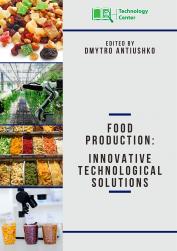Scientific and practical justification of innovative approaches to production of multicomponent semi-finished products for food products in the conditions of food security of the country
Keywords:
products for enteral nutrition, herodietetic purpose, emergencies, elderly people, aging, metabolic activity, diabetes, raw components, approaches to classification, milk A2, hard cheeses, enriched milk A2, carrot powder, milk carotenoids, amino acids of milk, β-casein A2, biological value, cheese yield, milk proteins, functional products, multicomponent semi-finished products of a high degree of readiness, mechanism of competitiveness, concentration, drying, resource saving, film-like electronic heater of radiating type, structural and mechanical indicators, temperature field, cattle breeding, food safety, beef, quality of consumed proteinAbstract
The production of functional products in the form of independent and multicomponent compositions based on vegetable semi-finished products of a high degree of readiness for further use during the manufacture of various food products is proposed. The proposed adaptive mechanism makes it possible to simulate the competitiveness of the agro-industrial sector in the conditions of taking into account the flow parameters of traditional micro- and macro-environments for the optimal adaptation of innovative approaches when implementing resource-saving hardware and technological solutions.
A resource-saving method for the production of multi-component puree-like semi-finished products with a high degree of readiness based on own plant raw materials of apple, Jerusalem artichoke, cranberry, beetroot and hawthorn has been developed. The hardware implementation of the resource-saving method is provided by the developed author's designs of unified mobile low-temperature devices, the feature of which is the reduction of energy and metal consumption, ensuring uniformity of heat supply, stabilization of the temperature range, the possibility of using secondary heat energy. The proposed method is unified due to the implementation of the concentration process as needed in the form of a film flow (unified rotary-film apparatus), in a flow (unified tubular apparatus) and boiling in mass (unified vacuum-evaporation apparatus). Also, due to technological necessity, there is an additional technological operation of drying, which is implemented on a fundamentally new thermal radiation single-drum roller dryer.
The film-like electronic heater of the radiating type has been improved. Thanks to the improvement, the following technical properties of the film-like electronic heater of the radiating type have been achieved in terms of the maximum temperature of the working surface (40...180 oС). At the same time, the IR wavelength set from 2.0 to 15 μm with a power of up to 800 W/cm2 and a technical efficiency factor (0.97) are optimal for heat and mass transfer processing of multicomponent vegetable semi-finished products. Thus, the reduction of: weight and specific metal capacity of the developed devices is ensured; duration of processing of thermolabile plant raw materials.
An equipment-technological line for the production of vegetable polycomponent semi-finished products with a high degree of readiness has been developed, which can be located directly on farmland for the cultivation of natural raw materials. The practical implementation of the proposed innovative approaches in the production of semi-finished products will allow to support the own capacities of farmland, modernization of processing and production sectors of agro-industry. The resulting functional polycomponent semi-finished products will allow expanding the range of food products with an increased content of functionally physiological ingredients, predicted rheological and organoleptic properties. The introduction of developed semi-finished products into the recipes of various food products will reduce the need to use synthetic ingredients, replacing them with natural components.

FOOD PRODUCTION: INNOVATIVE TECHNOLOGICAL SOLUTIONS
Downloads
Pages
Published
License

This work is licensed under a Creative Commons Attribution-NonCommercial-NoDerivatives 4.0 International License.

